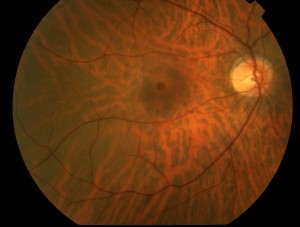Macular Hole
What Is a Macular Hole?
 Your doctor has discovered you have a macular hole. This means that the center part of your retina called the macula has developed a defect where the retinal tissue is stretched open. Because this tissue is responsible for our straight ahead or focused vision, this defect causes a gray or black spot in the center of vision at the focusing point. The surrounding vision is usually quite normal, creating a “donut” effect with a ring of normal vision and a hole in the middle. The vision is almost never completely lost by this problem. Occasionally, the “hole in the donut” is noted to get larger, but generally, this is not a severe progression, and the peripheral vision is maintained.
Your doctor has discovered you have a macular hole. This means that the center part of your retina called the macula has developed a defect where the retinal tissue is stretched open. Because this tissue is responsible for our straight ahead or focused vision, this defect causes a gray or black spot in the center of vision at the focusing point. The surrounding vision is usually quite normal, creating a “donut” effect with a ring of normal vision and a hole in the middle. The vision is almost never completely lost by this problem. Occasionally, the “hole in the donut” is noted to get larger, but generally, this is not a severe progression, and the peripheral vision is maintained.
What Causes a Macular Hole?
Although we do not know exactly what causes this problem, it is generally the result of degeneration or aging changes on the inner surface of the retina where the vitreous gel that fills the eye comes into contact with the center of the retina. This jelly can pull on the retina, creating the hole that we have observed in your eye.
Could It Happen to Both Eyes?
There is a small risk that a similar problem could happen to your other eye. The risk may be as high as 10 or 15%. There may be findings on your examination which allow us to identify a relatively higher or lower risk for you. The strain of the first eye being abnormal does not cause the other eye to develop this problem.
What Kind of Treatment is Available?
The only effective treatment is surgery. The operation is called a vitrectomy and consists of removing the vitreous gel that pulled the hole open in the first place. In order to seal the hole closed, your doctor will replace the gel with a temporary gas bubble at the time of surgery. This bubble will severely limit the vision in the operated eye for a period of a few weeks depending upon the type of gas bubble used. The body eventually absorbs this gas bubble and replaces it with natural eye fluids.
This surgery is usually performed under local anesthesia. There is usually very little pain. If you are contemplating surgery, please be aware that the results tend to be better for those patients who have a relatively “fresh” hole rather than a long-standing hole.
How Effective is Surgery?
Although surgery is effective in closing the hole in most patients (90% or more), it does not work for everyone. Occasionally, patients need additional operations. We generally recommend face-down positioning after surgery for about one week. While surgery is often successful without special positioning, the likelihood of success is enhanced if post-operative positioning is performed. This position may be assumed while lying, sitting, or standing. You can bathe, eat, and tend to your needs, but the likelihood of a good result is improved if this position can be maintained at all other times. We can provide you with some useful tips for maintaining this positioning as comfortably as possible.
The amount of vision that can be recovered with successful surgery is difficult to predict. Most will have some degree of noticeable visual improvement, but the improvement is usually gradual (weeks to months). The vision is rarely restored to “normal”. A cataract (clouding of the lens) usually develops after this operation, and many patients will end up ultimately having a cataract operation at some point after this surgery, often many months later. Other complications such as retinal detachment, infection, or hemorrhage are very infrequent, although when they occur, they can severely affect the vision and require additional surgery.
If you have any additional questions or concerns, please ask the doctor or a member of the staff.
